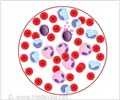
Principal investigator Tannishtha Reya from the University of California, San Diego School of Medicine, along with her colleagues found that a protein called Lis1 fundamentally regulates asymmetric division of hematopoietic stem cells, assuring that the stem cells correctly differentiate to provide an adequate, sustained supply of new blood cells.
Asymmetric division occurs when a stem cell divides into two daughter cells of unequal inheritance: One daughter differentiates into a permanently specialized cell type while the other remains undifferentiated and capable of further divisions.
"This process is very important for the proper generation of all the cells needed for the development and function of many normal tissues," Reya said. When cells divide, Lis1 controls orientation of the mitotic spindle, an apparatus of subcellular fibers that segregates chromosomes during cell division.
When researchers deleted Lis1 from mouse hematopoietic stem cells, differentiation was radically altered. Asymmetric division increased and accelerated differentiation, resulting in an oversupply of specialized cells and an ever-diminishing reserve of undifferentiated stem cells, which eventually resulted in a bloodless mouse.
Reya said that they found that a large part of the defect in blood formation was due to a failure of stem cells to expand. Instead of undergoing symmetric divisions to generate two stem cell daughters, they predominantly underwent asymmetric division to generate more specialized cells.
Advertisement
Reya said the findings shed new light on the fundamental regulators of cell growth both in normal development and in cancer.
Advertisement
Source-ANI











